MARIANI’SVirtual
Gourmet
FEBRUARY
9, 2014
NEWSLETTER

"KATRINA'S CHOICE" (2013) BY GALINA DARGERY
HAPPY VALENTINE'S DAY!
♡♡♡
❖❖❖
THIS WEEK
LAS VENTANAS AL PARAISO
By Andrew Chalk
In Defense of LaGuardia Airport
By John Mariani
NEW YORK CORNER
Le Cirque Cafe
By Marcy MacDonald
NOTES FROM THE SPIRITS LOCKER
San Antonio's Best Cocktails Right Now
By Andrew Chalk
❖❖❖
The Very
Well-Named
LAS VENTANAS AL PARAISO
By Andrew Chalk
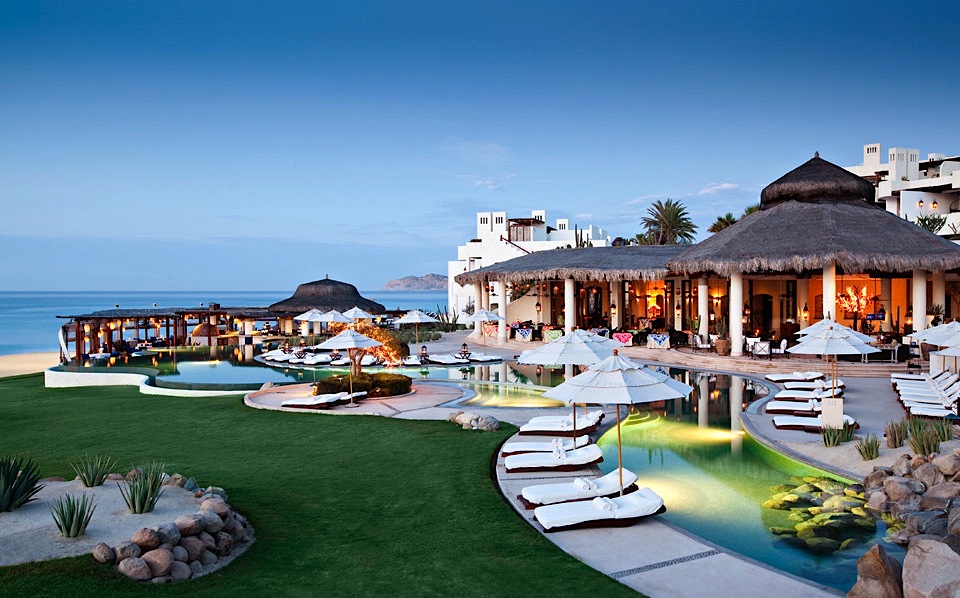 In Los Cabos,
an area known for a slew of luxury resorts,
including Capella
Pedregal, Esperanza,
and One
& Only Palmilla, it is an ambitious
goal for
Las
Ventanas Al Paraiso, a Rosewood property, to
strive to be the top luxury resort on Mexico's
Baja California Peninsula.
In Los Cabos,
an area known for a slew of luxury resorts,
including Capella
Pedregal, Esperanza,
and One
& Only Palmilla, it is an ambitious
goal for
Las
Ventanas Al Paraiso, a Rosewood property, to
strive to be the top luxury resort on Mexico's
Baja California Peninsula.
The challenge is
taken up with the guests' arrival at Los Cabos
International Airport, where visitors are greeted by a
resort employee driving a Mercedes Geländewagen
who packs them and their luggage into the vehicle and
offers water and cold beer for the 20-minute drive to
the resort. Upon entering the
resort, the property almost takes you by surprise--an
understated, single-story, pueblo-style frontage
designed, perhaps, more to conceal what is inside than
to display it. The one concession to an audacious
statement is a colossal agave plant standing to
attention on a spinney in front of the main entrance.
Inside the entrance, the ground tumbles
away to the ocean, a setting enjoyed best in the late
afternoon when the western sun bathes the resort,
beaches and the Pacific Ocean beyond.
Your
luggage is whisked away by staff who already know your
name and where you came from. A Junior Suite is
a large, white-walled cave with a sumptuous king-size
bed and amenities befitting a five-star facility:
flat-screen satellite TV, DVD player, minibar, coffee
machine, complimentary bottled water and a safe.
Floor-to-ceiling windows lead to a balcony obliquely
overlooking the ocean and large enough for three
couples to socialize without feeling cramped. At one
end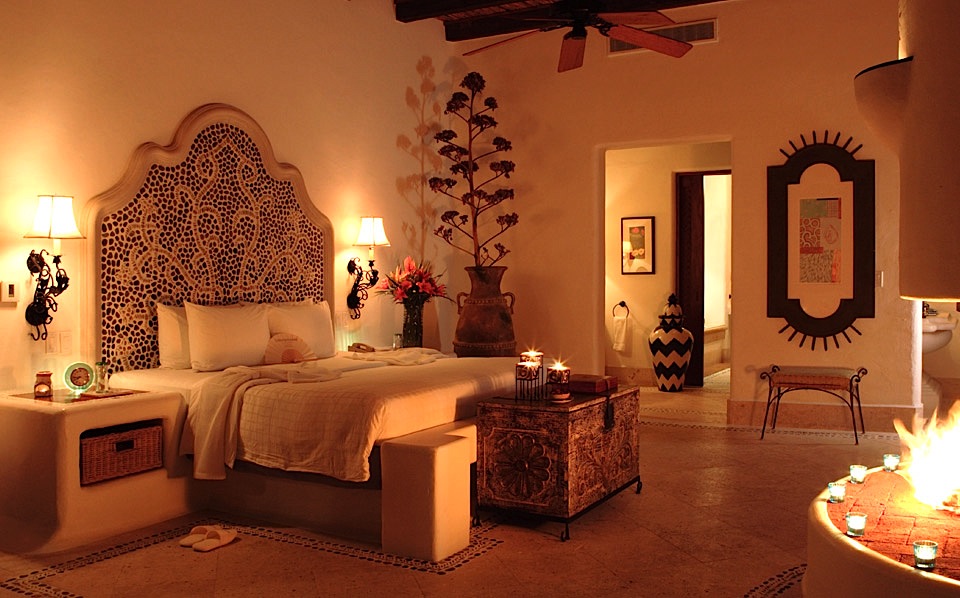 , a circular staircase leads
to a balcony, well positioned for avid grey whale
watchers (Los Cabos is a favorite site for this
pastime in late February and early March) but also
serving as the site for a massage. Each suite has two
butlers, working shifts, to serve guests’ needs. The
bathtub is huge--the bathtub accommodates more than
one person and the walk-in shower, with rainforest
shower heads, is similarly expansive. Wi-fi is
fairly dependable.
, a circular staircase leads
to a balcony, well positioned for avid grey whale
watchers (Los Cabos is a favorite site for this
pastime in late February and early March) but also
serving as the site for a massage. Each suite has two
butlers, working shifts, to serve guests’ needs. The
bathtub is huge--the bathtub accommodates more than
one person and the walk-in shower, with rainforest
shower heads, is similarly expansive. Wi-fi is
fairly dependable.
In fact, this 960-square foot
Junior Suite exceeds the area of some of the largest
available facilities at other resorts. For example, at
the Radisson Blu St. Martin a Superior Room is 430
square feet and a Deluxe Grand Suite is only
1,050.
Moving up, Luxury Villas
at Las Ventanas come with 1,600 square feet and
a private infinity pool and hot tub. From there, the
rooms get larger and larger, with the two-bedroom
penthouse suites at 3,250 square feet, with a full
kitchen and a wine cellar.
EATING AND DRINKING
Dining opportunities
are many at Las Ventanas. At the main restaurant (below), the theme
is “locally sourced, nationally inspired.”
French-born Executive Chef Fabrice Guisset
sources meat and vegetables from local farms, fish
from fishermen of the Pacific and herbs from the
resort’s own extensive herb garden. The La Cava Wine
Room off the main restaurant (below, right) offers
groups of up to 14 a private room for their meal.
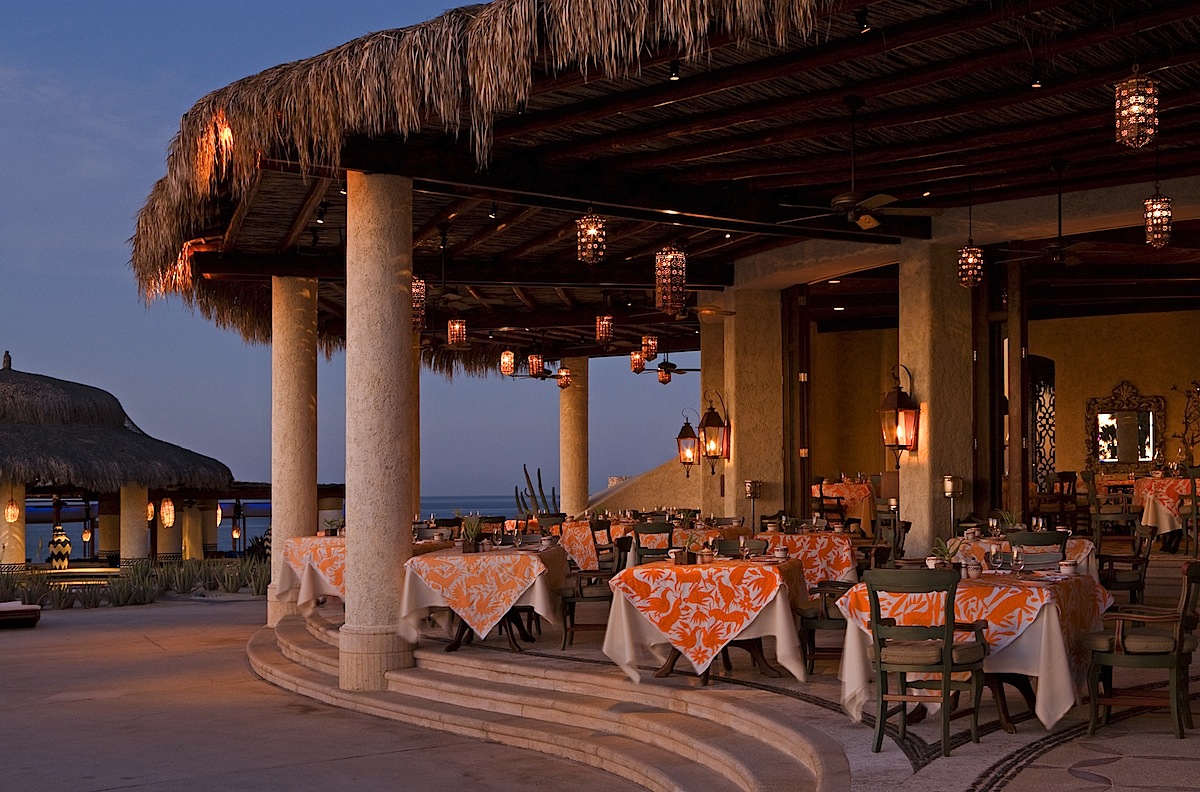 The
restaurant's cuisine style might be described as
"Mexico City meets New American and Modern
French." For example, roasted striped bass with
lentil purée, crispy bacon, sweet potato and
raw jalapeño sauce is a melting pot of national
influences. Here, the lentils form a mushy bed for the
fillet of fish, which is topped with small-diced
sautéed sweet potato and squares of fried
bacon. Braised short rib “pascalito” with pumpkin seed broth,
serrano chile, pico de gallo and homemade
jalapeño tortillas merged the succulence of the
beef with a piquant serrano chile sauce cut by the
mitigating influence of the pumpkin seed broth.
The
restaurant's cuisine style might be described as
"Mexico City meets New American and Modern
French." For example, roasted striped bass with
lentil purée, crispy bacon, sweet potato and
raw jalapeño sauce is a melting pot of national
influences. Here, the lentils form a mushy bed for the
fillet of fish, which is topped with small-diced
sautéed sweet potato and squares of fried
bacon. Braised short rib “pascalito” with pumpkin seed broth,
serrano chile, pico de gallo and homemade
jalapeño tortillas merged the succulence of the
beef with a piquant serrano chile sauce cut by the
mitigating influence of the pumpkin seed broth.
Desserts come with a sugar overdose
you may be familiar with from high-end Mexican
restaurants in the U.S. We had a natilla de horchata,
rice custard, cinnamon pastry and xoconostle (prickly-pear fruit) ice cream.
We confined our meals to the main
restaurant, but there are plenty of more casual
options. The Sea Grill offers Cocina del Fuego grilled
foods such as free-range Rock Cornish game hens, veal
chops and lobster tail.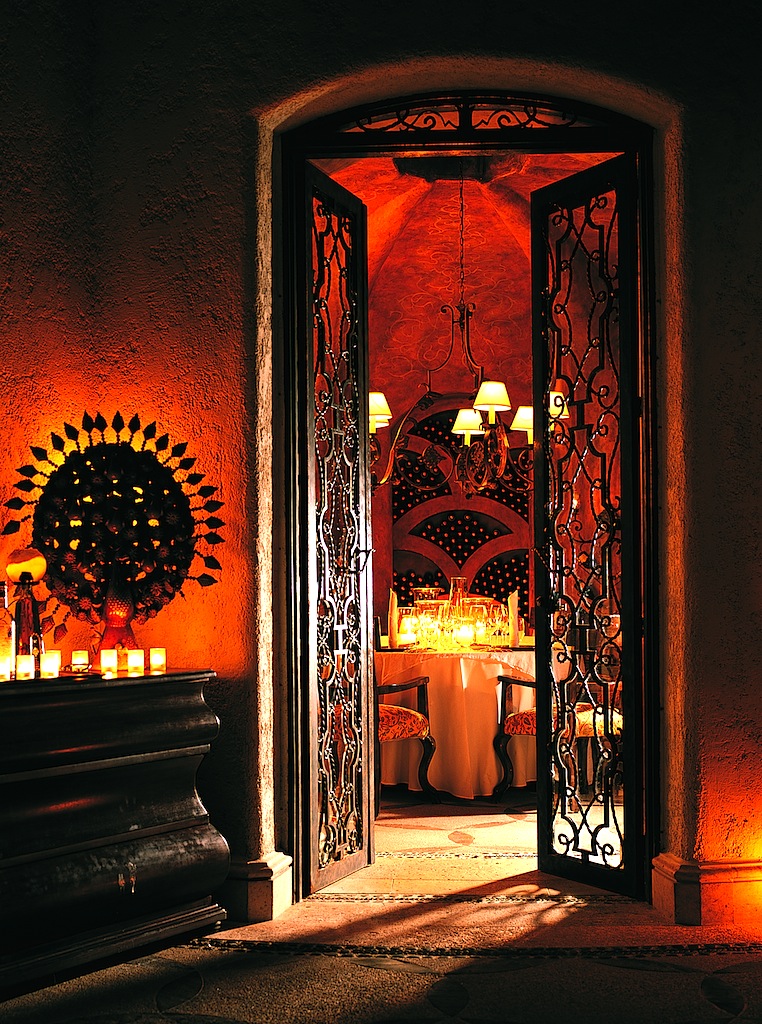 La
Marisqueria at the Sea Grill is a raw bar offering a
selection of ceviches and shellfish. The Molcajete
Menu employs the molcajete,
a volcanic stone mortar and pestle, to prepare dishes
with ground spices.
La
Marisqueria at the Sea Grill is a raw bar offering a
selection of ceviches and shellfish. The Molcajete
Menu employs the molcajete,
a volcanic stone mortar and pestle, to prepare dishes
with ground spices.
On the other side
of the resort is the ceviche, sushi and tequila bar.
This is an outside rectangular bar around which guests
can enjoy the apparently unorthodox combination of
sushi and sashimi washed down with the spirit of the
blue agave plant. It is a combination that works. The
bitter backbone of the tequila is ameliorated by the
rice in the sushi. The bar is popular from late
morning until long after nightfall.
OTHER ATTRACTIONS
Appropriately
between the restaurant and the Sea Grill is the
massive infinity pool, which offers room for restful
swimming or vigorous laps. At one end, the obligatory
swim-up bar takes you into one side of the sea grill.
The Fitness Center and Spa (below), at 2,900 square feet, offers
an indoor-outdoor experience rooted in local
tradition, called the ‘Four Elements’ treatment menu,
inspired by the ancient healers of Baja. When
undergoing the treatments the dominant feeling is
tranquility.
The beach at Los Cabos is
justifiably famous, not only for the ferocity of
the Pacific but because Las Ventanas is well sited at
a relatively calm spot on the Pacific.
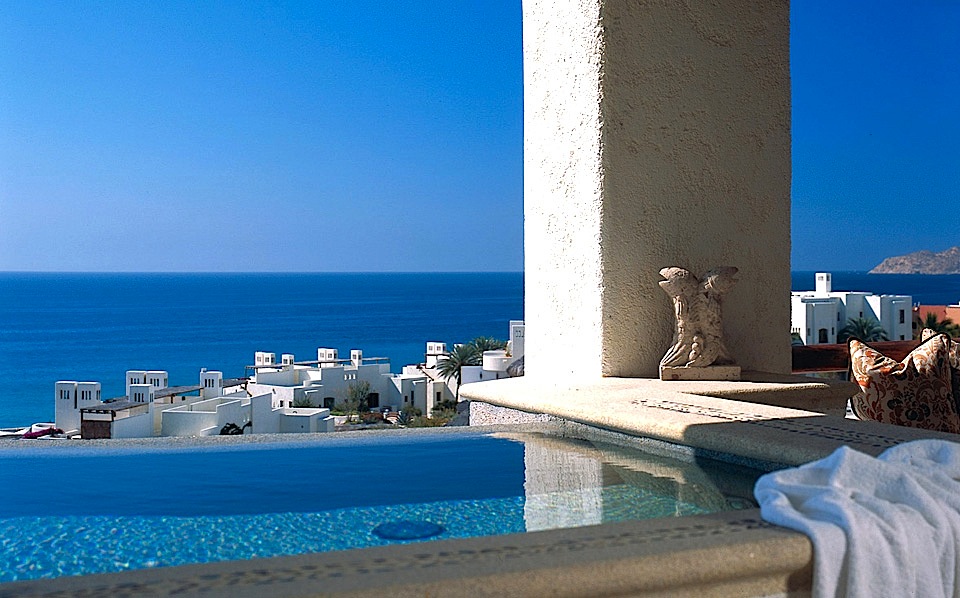 Other activities at Las
Ventanas include tequila lessons, incorporating a
tasting much like a wine tasting. A "Department of
Romance" can help plan weddings and special proposals
(one example: ‘Will You Marry Me?’ etched in the sand
and viewed from a helicopter).
Other activities at Las
Ventanas include tequila lessons, incorporating a
tasting much like a wine tasting. A "Department of
Romance" can help plan weddings and special proposals
(one example: ‘Will You Marry Me?’ etched in the sand
and viewed from a helicopter).
The town of San
José del Cabo is within a ten-minute drive. Its
center is small and very walkable. The most
interesting neighborhood is just off the town square
behind the Cathedral San José, an arts district
where more than 15 galleries dot cobbled streets that
also contain the Baja Brewing Company, a craft brewer
run by a grumpy ex-pat American, and a burgeoning
restaurant scene. The best time to visit is
the Thursday night art walk. So far
there are only six restaurants (representing Mexican,
New American, brewpub and, believe it or not, Thai,
cuisines) but evidence of public works to enhance the
area is everywhere, so it is growing.
It
should also be mentioned that the resort makes
departure less stressful than at other resorts.
Mexican government-approved resort personnel called
Airport Ambassadors escort Las Ventanas guests through
airport security and into a private VIP lounge with
wi-fi, dining and beverages.
❖❖❖
IN
DEFENSE OF LAGUARDIA AIRPORT
By John Mariani
Vice President Joe Biden’s recent
characterization of LaGuardia Airport as being akin
to one in a Third World country is neither idle nor
flippant. Indeed,
many would argue that airports in some Third World
countries are even more modern than LGA. But to
me, that’s not necessarily a bad thing.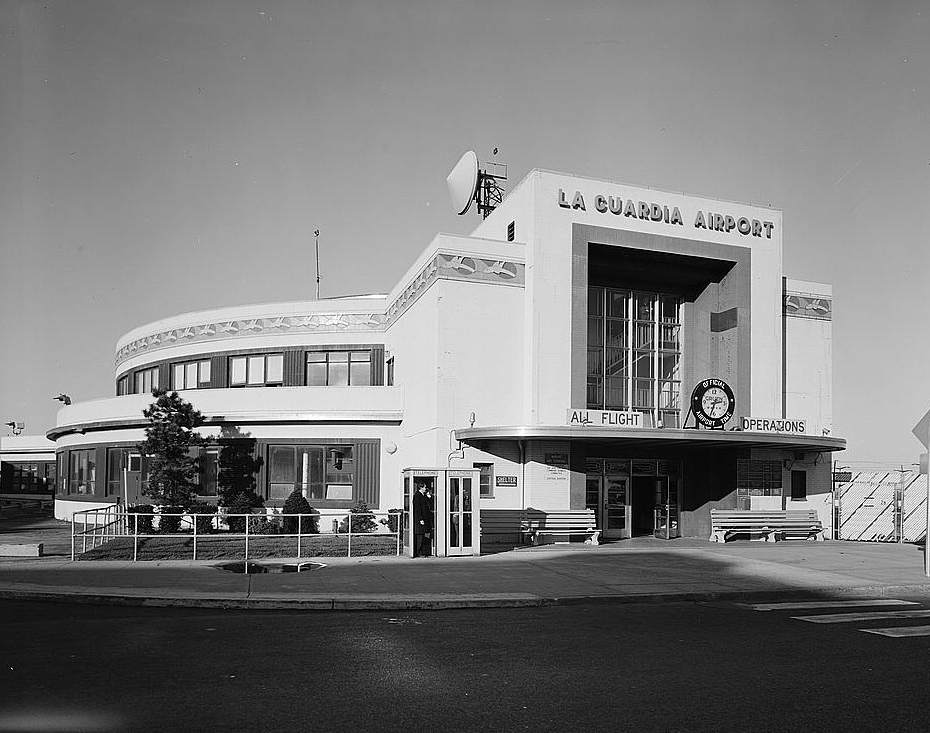
Old-fashioned, small airports may be out
of date by not looking like vast shopping malls or by
not being configured in a maze-like way so that it
takes an exiting passenger half an hour to get to the
street. LGA’s
size is what makes it convenient, unlike the torturous
new Delta Terminal at JFK. And, while I was in awe at the
modernity of the Zurich Airport, it took me nearly 30
minutes—not counting security—to wend my way up stairs
and escalators, along shopping boutiques and endless
corridors to get to my flight gate. Miami is
even worse, though you'll get plenty of cardio
exercise along the way.
Unlike so
many larger, more modern airports, LGA requires no
monorail or train trips to get from terminal to
terminal. I
find DFW, Atlanta, Denver and Las Vegas’ airports
unbearable for the amount of time I have to spend
getting from my gate to the main terminal. I loathe
that droning robotic voice barking “YOU ARE NOW
APPROACHING TERMINAL 9,” knowing I have three more
stops before I get to the main terminal exits.
The very fact that LGA is old means
that there is very little distance between the entry
doors, the airlines desks and the gates. Once
through security it takes no more than a minute or two
to reach any gate. Today LGA takes up 680 acres and
has 76 gates. And increasingly there are more
and better options for food and drink at LGA, with
more on the way.
And let’s face it, how many people want to sit
down to a long dinner at an airport?
 LGA, which was
built for the World’s Fair of 1939-1940, has, of
course, been updated continuously since then,
including the control tower, parking lots, and
extensions and additions, including the Delta and
USAir Terminals. It
is certainly ridiculous that there is no modern subway
to LGA, but there are more than enough buses, taxis,
and discount parking lots to make access pretty easy. If I park
at one of the discount long-term parking lots –some
run by rental car companies--just across from LGA, a
shuttle bus gets me to my airline in under five
minutes.
LGA, which was
built for the World’s Fair of 1939-1940, has, of
course, been updated continuously since then,
including the control tower, parking lots, and
extensions and additions, including the Delta and
USAir Terminals. It
is certainly ridiculous that there is no modern subway
to LGA, but there are more than enough buses, taxis,
and discount parking lots to make access pretty easy. If I park
at one of the discount long-term parking lots –some
run by rental car companies--just across from LGA, a
shuttle bus gets me to my airline in under five
minutes.
And
then there is the uniquely beautiful, very
old-fashioned Marine Air Terminal (above), opened in
1940 as a landing base for the great flying boats like
the two-decker Pan Am Clipper (left), its first
departure on March 31, 1940, carrying just nine
passengers. The
outbreak of war and the demise of the flying boats
meant the closure of the Marine Air Terminal in 1950,
though it was re-opened in 1985 for the Boston and DC
shuttle and other flights. There was, for a while, a water
taxi linking the airport to Wall Street.
Since 1940 the
basic shape and décor of the Marine Air
Terminal—now called “A”--has changed little, so its
allure lies in its small size and in the illusion that
you are entering a terminal built when passenger
flights were still a glamorous fantasy for most
people. It
was designed by the architectural firm of Delano and
Aldrich in a distinctly 1940s art déco style
within a circular room containing a 235-foot long
Social Realist mural by James Brooks (1906-1992)
titled “Flight” (below)
and a bust of Mayor Fiorello LaGuardia. Brooks worked
for four years on the mural, yet in one of those
paranoid acts of insane modernization (some  say because the mural contained Left
Wing symbols), it was painted over, not fully restored
to magnificence in 1980.
say because the mural contained Left
Wing symbols), it was painted over, not fully restored
to magnificence in 1980.
There’s
a small concession stand and restaurant in the room,
and nothing more. But stand there in the center of
that historical rotunda and look up and around at the
Pantheon-like circumference and you’ll see a panorama
that exalts Man’s age-old desire to lift off from the
earth like an eagle—figures of Daedalus, da Vinci, the
Wright Brothers, and the Pan Am Clipper, mixed in with
abstract motifs.
Looking at that mural in that fine building, I
am reminded of F. Scott Fitzgerald’s sentiments at the
end of his novel The Great Gatsby,
when man felt “compelled
into an aesthetic contemplation he neither understood
nor desired, face to face for the last time in history
with something commensurate to his capacity for
wonder.”
LaGuardia Airport
may not be the most modern airline terminal in the
world, but for those who remember a time when flying
was a wonder, not sheer agony, there’s still something
of the old spirit there.
❖❖❖
NEW YORK CORNER
by Macy MacDonald
Le Cirque Café
One Beacon Court
151 East 58th Street (off Third Avenue)
212-644-0202
lecirquecafe.com
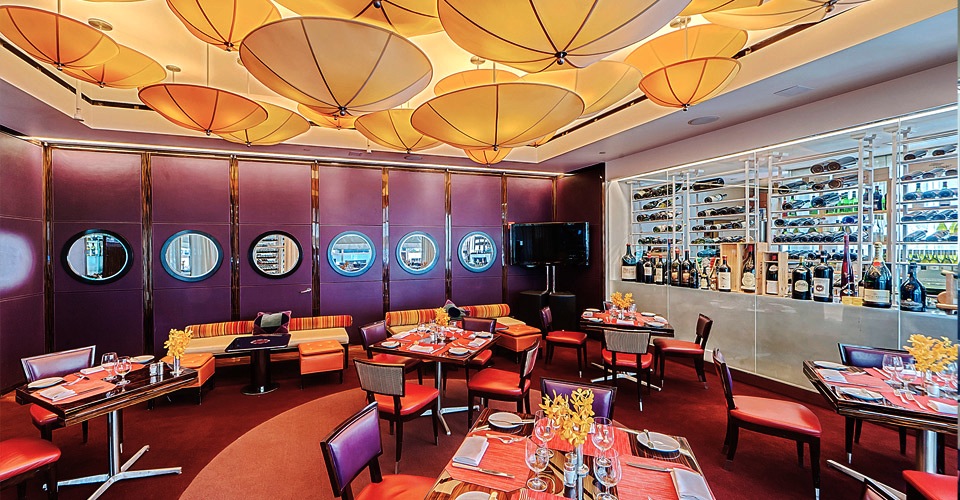
On the coldest
night of the year, Le Cirque was jumping.
Not exactly the kind of thing one says about
one of the most elegant of New York's great
restaurants, but since the opening of its new
performance space, Le Cirque Café, it's become
the coolest new hotspot in town.
Its enormous portholes suggest the kind of Old World ocean liner crossings that made the long-defunct White Star Line come alive. Sculptural umbrellas of all sizes hang upside down from the high ceiling. And when young crooner, Cole Rumbough, sang “Pennies from Heaven,” gourmands at almost every table looked up. Just 23, Rumbough comes to this exclusive world naturally: his grandmother, actress Dina Merrill, was brought up in the 1950s, and now her grandson has a repertory of 500 songs from the period. He is finishing his last year of music study at The New School and uses his accomplished classmates as his small back-up orchestra.
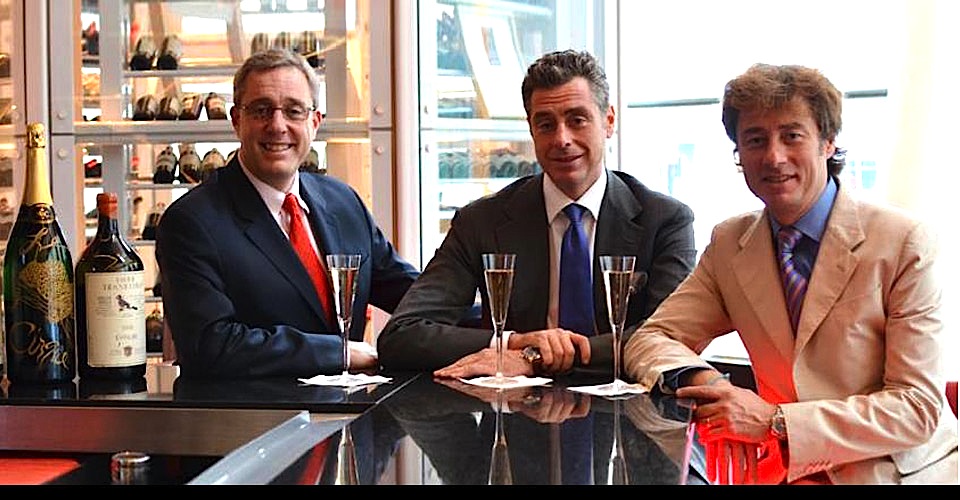 Le Cirque’s owner, the Maccioni
family (Mario, Mauro and Marco, left) and wait
staff are so professional that only they knew what was
coming--three hours of music from pre-appetizer to
post-dessert that recalled the days of luxury living
of a bygone age
As soon as we were seated, our waiter served
warm rolls
warm and
took our drinks and wine order. The
gin-and-tonic was perfectly tart, the
Puligny-Montrachet Bernard Bonin Les Folatières
2009 and a bubbly Laurent Perrier, Cuvée
Rosé Brut, were served as cold as frigid air
outside.
Le Cirque’s owner, the Maccioni
family (Mario, Mauro and Marco, left) and wait
staff are so professional that only they knew what was
coming--three hours of music from pre-appetizer to
post-dessert that recalled the days of luxury living
of a bygone age
As soon as we were seated, our waiter served
warm rolls
warm and
took our drinks and wine order. The
gin-and-tonic was perfectly tart, the
Puligny-Montrachet Bernard Bonin Les Folatières
2009 and a bubbly Laurent Perrier, Cuvée
Rosé Brut, were served as cold as frigid air
outside.
Le Cirque is famous for so many dishes that we
mixed our tastes with old and new entries. The
Caesar Salad "Le Cirque" never disappoints as it
perfectly replicates the intentions of the original to
which the kitchen adds strips of chicken that enrich
but don't dominate the rest. The
Fall Garden Greens of radicchio, endive, sesame with a
raspberry vinaigrette, was perfectly dressed,
delightfully crunchy.
A simple shrimp cocktail is anything but
here—six-inch jumbos with a cocktail sauce with the
extra snap of Tabasco. "Tempura-Style" fried calamari was
new to us, the batter light and crunchy, and Burgundy
truffle risotto made with Vialone Nano rice with
shaved truffles, was impeccably executed.
I could have survived on the breadbasket alone,
but there were several main courses to consider, and
different wines to imbibe. The grilled petit steak
might have been just another strip steak, but, ordered
black-and-blue, it was crisp on the outside and almost
still mooing on the inside. Served with wild
mushrooms, the jus
was perfect for dipping the pommes frites. We ordered
Peter Michael Les Pavots Cabernet Sauvignon 2009,
which rounded off the dish perfectly. 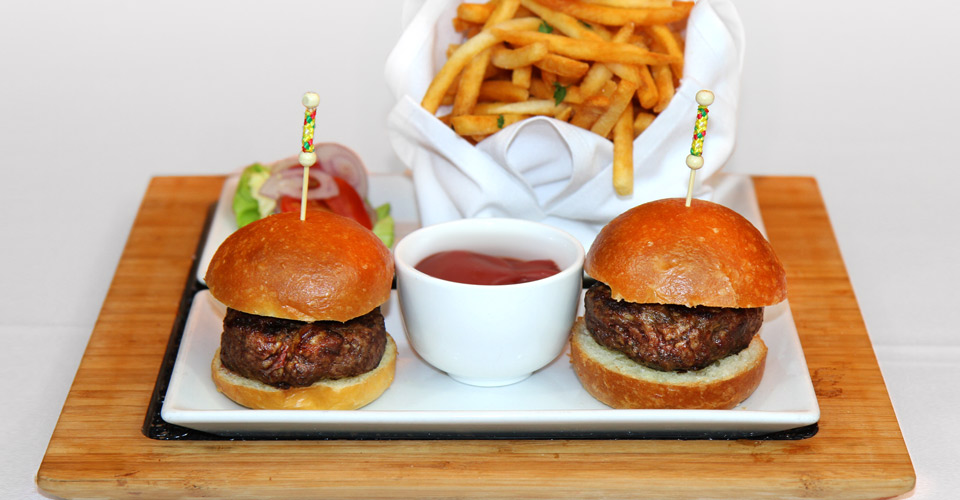
Scottish salmon was served medium-well, exactly
as requested, soft without being rubbery.
Accompanied by acorn squash, watercress, orange,
and tiny rutabaga made it even more decorative and
tasty,accompanied by a crisp Philippe Colin
Chevalier-Montrachet 2007.
And who could resist the Mini Cheeseburgers "Le
Cirque" (right),
with like
three kinds of mustard, paired with a nice Rocca di
Frassinello Baffonero Merlot? Either  you love duck, as in duck
confit, or you don't.
Too often the
abundance of duck fat congeals into grease in a
confit, but here it was wholly rendered and enhanced
with the flavors of the rye berries and apple. For
this we chose a dry rosé, Nationale 7 Domaine
Rimauresq 2012,. A surprise dish, croque
monsieur—French grilled cheese--transported us back to
school days in Paris, but now eaten with knife and
fork and cloth napkins.
you love duck, as in duck
confit, or you don't.
Too often the
abundance of duck fat congeals into grease in a
confit, but here it was wholly rendered and enhanced
with the flavors of the rye berries and apple. For
this we chose a dry rosé, Nationale 7 Domaine
Rimauresq 2012,. A surprise dish, croque
monsieur—French grilled cheese--transported us back to
school days in Paris, but now eaten with knife and
fork and cloth napkins.
Coffee? Only if you want to stay awake; the
decaf (with a shot of Drambuie) if you don't have far
to go. That and Cole Rumbough's songbook warmed
this freezing night from the inside out.
Cole Rumbough (left)
performs once monthly on Wednesdays.
Le Cirque Café is
open for lunch Mon.-Fri., for dinner Mon.-Sat.; Menu
2 Course Lunch $28, 2 Course Dinner $38.
NOTES FROM THE SPIRITS
LOCKER
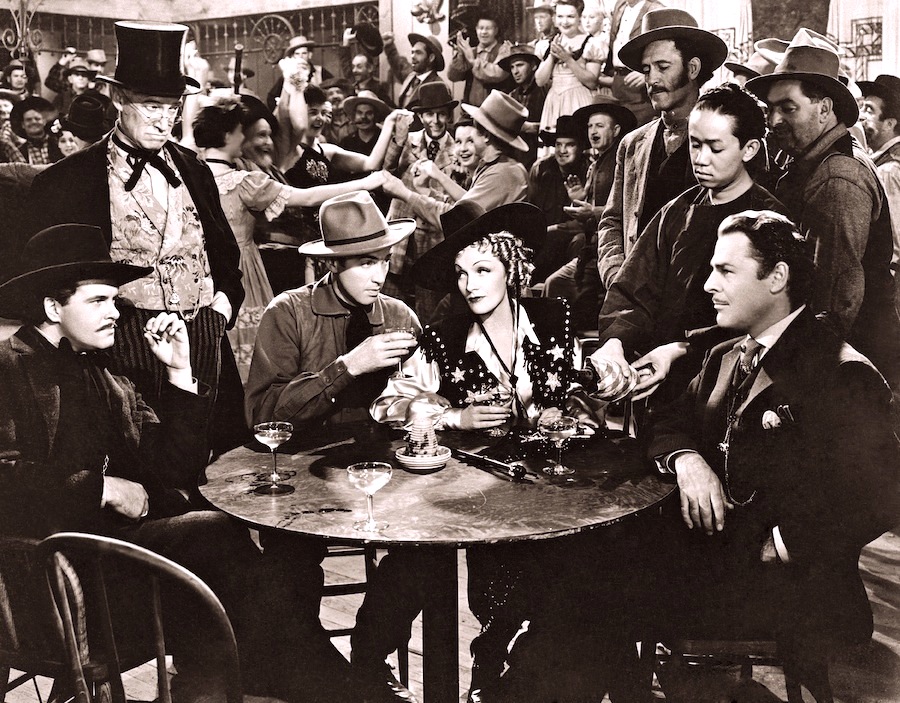
San Antonio, which you might be
surprised to find is the nation’s seventh largest
city, has become something of a factory for
cocktail innovation since the advent of the San
Antonio Cocktail Conference two years ago. Having just
returned from the third annual conference, I can
report that it is bigger, better and ever more
national in attendance.
Trade support extends
from multinationals, down to local distillers with
just one pot still to their name. Adventurous, specialized cocktail
bars have sprung up all all over town. I used some
recent trips to check them out and come up with a
list of my favorites.
James
Stewart, Marlene Dietrich and Brian Donlevy in
"Destry Rides Again" (1939)
Ocho--This bar in the Hotel Havana on the
River Walk may be Cuban-themed, but manager Sandra
Puente describes it as very much pan-Latin.The airy
street-level bar is paired 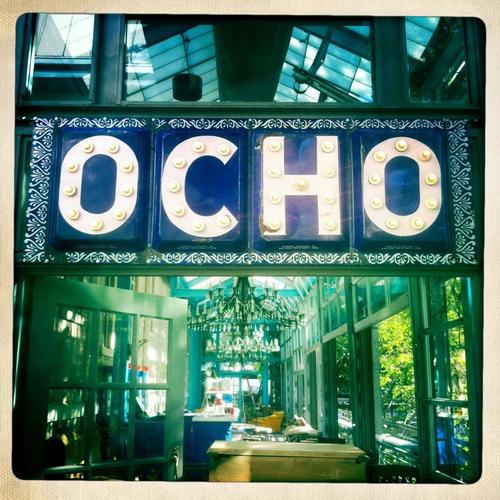 with a dark
and mysterious basement counterpart. Upstairs (right) the glass and steel
conservatory looks rather like a birdcage, with the
river just outside. Among
the spirit selections behind the bar are Republic
tequila and Tito’s vodka, both made in Austin. The
most popular cocktail is the mojito but they also do
specialties like the “Trace of sin,” a Buffalo Trace
bourbon-based drink with lime juice, simple, cinnamon
simple syrup and grapefruit juice.
Bartender Hector also demonstrated the ‘Hemingway
Daiquiri’, classic built around white rum.
with a dark
and mysterious basement counterpart. Upstairs (right) the glass and steel
conservatory looks rather like a birdcage, with the
river just outside. Among
the spirit selections behind the bar are Republic
tequila and Tito’s vodka, both made in Austin. The
most popular cocktail is the mojito but they also do
specialties like the “Trace of sin,” a Buffalo Trace
bourbon-based drink with lime juice, simple, cinnamon
simple syrup and grapefruit juice.
Bartender Hector also demonstrated the ‘Hemingway
Daiquiri’, classic built around white rum.
1½.oz Mount Gay Silver Eclipse rum
½ oz Luxardo Maraschino liqueur
½ oz lime juice
½ oz simple syrup
¾ oz grapefruit juice
In a shaker, add all ingredients, shake on ice
and double strain. Garnish with a slice of the
grapefruit.
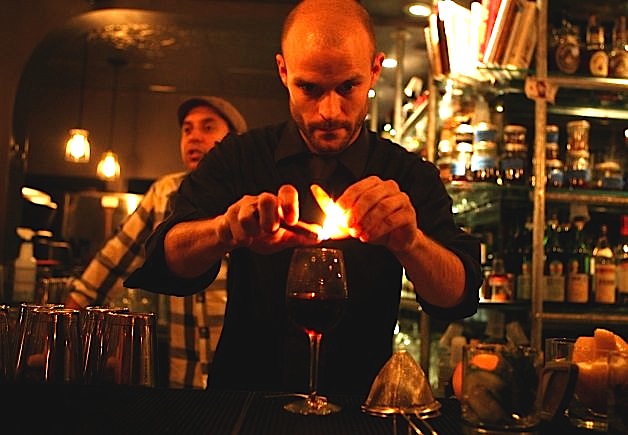 The
Brooklynite–-This San Antonio bar has the
look and feel of the classic speakeasy: there is the
windowless room, over-the-top period chandeliers,
everything except secret passwords for access.
Situated halfway between downtown and Pearl (a new and
up-and-coming entertainment and residential complex in
the old Pearl brewery), The Brooklynite gives the lie
to those who claim the two entertainment centers of
San Antonio are too far apart to walk from one to the
other. Just stop for libations here on the way. Owner
Jeret Peña is a veteran of the San
Antonio bar scene having worked, among other gigs, at
the oldest bar on the River Walk, The Esquire
Tavern.
The
Brooklynite–-This San Antonio bar has the
look and feel of the classic speakeasy: there is the
windowless room, over-the-top period chandeliers,
everything except secret passwords for access.
Situated halfway between downtown and Pearl (a new and
up-and-coming entertainment and residential complex in
the old Pearl brewery), The Brooklynite gives the lie
to those who claim the two entertainment centers of
San Antonio are too far apart to walk from one to the
other. Just stop for libations here on the way. Owner
Jeret Peña is a veteran of the San
Antonio bar scene having worked, among other gigs, at
the oldest bar on the River Walk, The Esquire
Tavern.
The theme here is constant innovation and and an autarchic approach to ingredients. They make their own cordials, ginger beer, tinctures, bitters and vinegars. Maple vinegar, cranberry vinegar, and others are everyday components here. Peña is a big fan of using vinegars instead of citrus to add depth in the acid component of a drink, with new cocktails coming out weekly. The most popular are rewarded with a place on the regular menu.
Rather than turn over part of the small building to a kitchen, The Brooklynite supplies food through an ever-rotating selection of food trucks that park right outside the front door.
Not surprisingly, the place gets packed at weekends “85 percent locals”, says Peña. It is good to know that they take reservations if you want to be sure your party can get a particular table. Peña demonstrated the ‘Gibraltar’ to me, a cocktail he devised based on a Champs Elysées.
1 ½ oz Calvados
3/4 oz pear liqueur
½ oz fresh lemon
1/4 oz simple syrup
Mezcal in a spray container.
Add Calvados, pear liqueur, lemon and simple syrup to
a shaker with ice. Shake and double strain. Serve in a
Champagne coupe glass sprayed with Mezcal.
BAR 1919
–Named in memory of
the year that saw the ratification of the 18th
Amendment to the U.S. Constitution, instituting
Prohibition, 1919
is located in the Blue Star arts and entertainment
complex on the river walk a mile south of town. The
bar itself is easy to miss, being at basement level on
one end of an undistinguished mixed use strip. Inside,
the atmosphere is in the “not see and not be-seen”
genre of design; the lights are low, the windows
covered over’ all light projects out from the bar.
 Owner Don Marsh is a 24-year
veteran of the San Antonio cocktail scene, having
worked at numerous bars, including Bohanan’s, and
self-taught at each stage. The specialty at 1919 is
dark liquor, that is, whisky. Marsh claims to have the
largest selection in the city. Yet he is
also a fan of tequila and mezcal and shows a large
selection of each. To illustrate where he is less of a
fan, he offers up that he only has two vodkas. He is
also a fan of beers and has over 100. A back room
functions as an event space for seminars by distillers
and brewers to avid fans of the drinks.
Owner Don Marsh is a 24-year
veteran of the San Antonio cocktail scene, having
worked at numerous bars, including Bohanan’s, and
self-taught at each stage. The specialty at 1919 is
dark liquor, that is, whisky. Marsh claims to have the
largest selection in the city. Yet he is
also a fan of tequila and mezcal and shows a large
selection of each. To illustrate where he is less of a
fan, he offers up that he only has two vodkas. He is
also a fan of beers and has over 100. A back room
functions as an event space for seminars by distillers
and brewers to avid fans of the drinks.
1919 runs an unusual loyalty program. Customers with coins minted for the bar can obtain discounts on a different drink each week.
For a taste of 1919,
Marsh made me a True Azul and served it in a vintage
glass (left),
from 1944 in fact.
1 1/2 oz infused tequila (1919 uses a reposado infused with poblano, serrano and red bell peppers),
1/4 oz crème de violet
1/2 oz honey syrup
1/2 oz fresh lime juice
Smoked sea
salt
Add all tequila, creme de violet, honey syrup and lime
juice into a pint glass with ice and shake.
Strain into a cocktail glass half lined with smoked
sea salt and a lime wedge garnish.
Bohanan’s—A candidate
for ground zero in the San Antonio cocktail
scene, this
steakhouse owned by Mark Bohanan is regarded
as one of the best in Texas. The bar was opened in
2008 in the downstairs space of the same building. In
2011 he did a serious makeover, bringing in Sasha
Petraske of New York 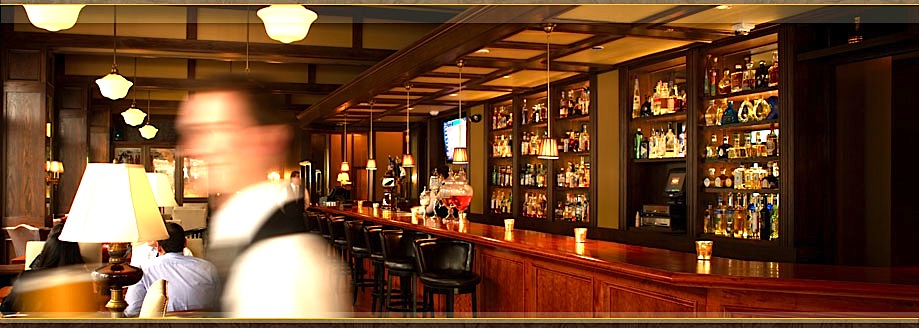 and London’s Milk and Honey to remake the cocktail list to give it
an edge. Extensive staff training and the purchase of
a specialized ice-making machine were part of the
upgrade, as were quarterly return visits by Petraske
to check on progress. The cocktails here take on a
number of genres but they have in common a certain
refined swagger in their composition.
and London’s Milk and Honey to remake the cocktail list to give it
an edge. Extensive staff training and the purchase of
a specialized ice-making machine were part of the
upgrade, as were quarterly return visits by Petraske
to check on progress. The cocktails here take on a
number of genres but they have in common a certain
refined swagger in their composition.
The décor here is the most upscale of
all the places surveyed here. If Ocho is Hemingway’s
Havana and The Brooklynite a speakeasy, then Bohanan’s
is a private club replete with overstuffed sofas and
bookshelves. During most of the year the off-street
courtyard affords a place for those who want to smoke
cigars. The bar’s location on downtown Houston Street
also makes it a convenient stop before or after the
theater.
Bartender
Alex Smith showed me how they make an Old Fashioned at
Bohanan’s. This is a cocktail built in the glass.
3-4 dashes Angostura bitters
1 spoonful club soda
2 oz Buffalo Trace bourbon
Ice to chill
3-4 inches of orange zest
Place the sugar cube in an Old Fashioned glass and sprinkle Angostura bitters on top. Add club soda. Muddle to a paste so that the sugar cube is fully broken up.
Add
bourbon and ice cubes. Garnish with orange zest.
Wine Column Sponsored by Banfi Vintners
Looking for Love in All The Right Bottles
by
Cristina Mariani-May,
co-CEO
of Banfi Vintners
America's leading
wine importer
 Charming day, Valentine’s
is. Who
can argue with romance, candlelight, treats and
seduction? My
only argument is why we relegate this celebration to
just once a year.
Love is never redundant, after all, nor should
be the ways we express it. Much like the range of wines
available and the myriad of occasions in which to
enjoy them.
Charming day, Valentine’s
is. Who
can argue with romance, candlelight, treats and
seduction? My
only argument is why we relegate this celebration to
just once a year.
Love is never redundant, after all, nor should
be the ways we express it. Much like the range of wines
available and the myriad of occasions in which to
enjoy them.
One of my personal favorite wines can best be
described as pure romance in a bottle. Rosa Regale,
a sparkling red from Italy, is the poster child for a
Valentine’s Day wine.
Sparkling, heart-colored red, festive,
relatively low in alcohol, fruity, Rosa Regale goes
great with savories such as ham and quiches, and is a
sensual pairing with chocolate, especially dark
chocolate as well as raspberries and strawberries. There’s
even a legend that Julius Caesar, when competing with
Mark Anthony for Cleopatra’s affections, sent the
Egyptian monarch a shipment of Brachetto, the
exclusive grape in Rosa Regale. For those
same reasons and more, it is also a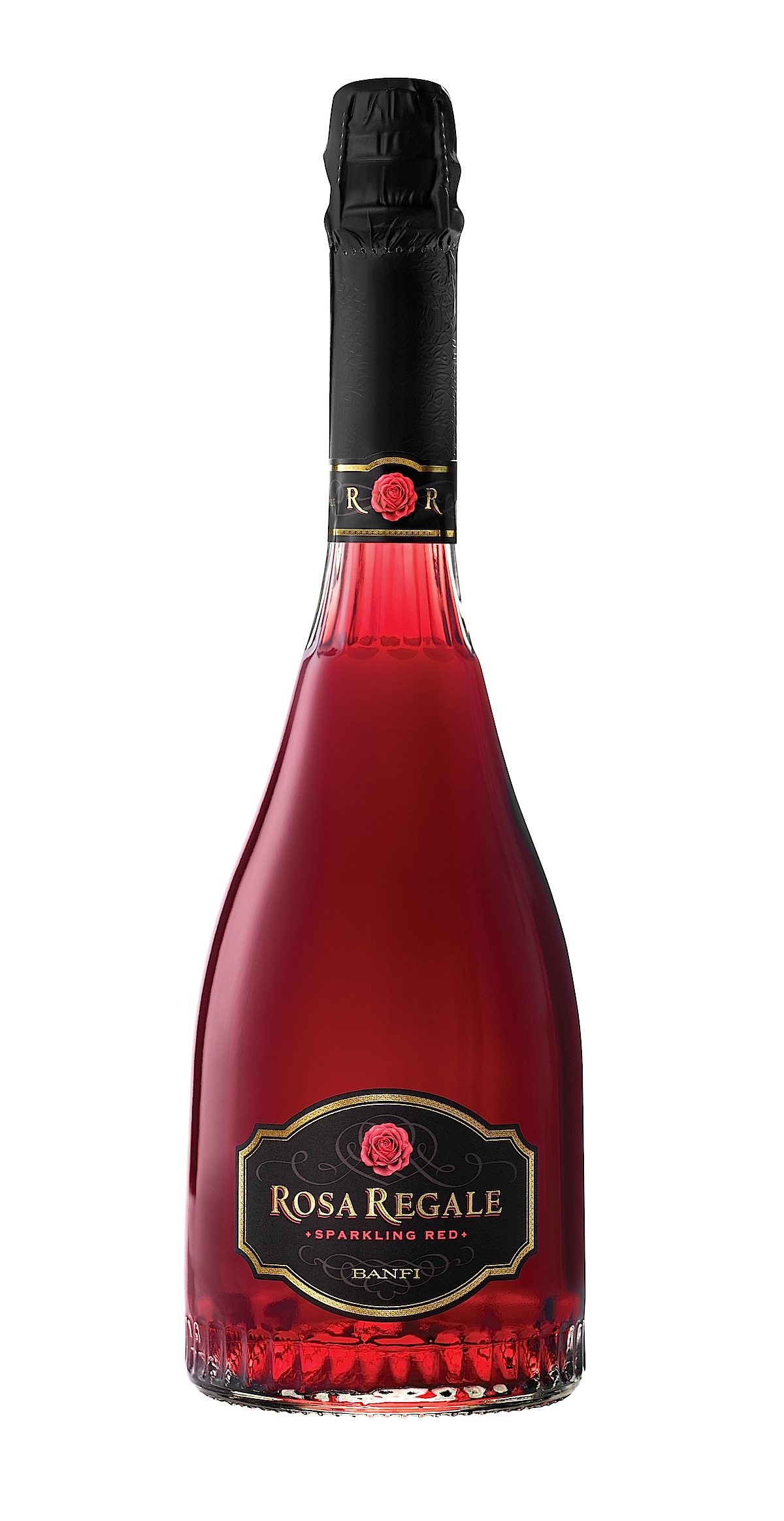 great wine
for Thanksgiving, Christmas, Hanukkah and new year;
Mother’s Day, Easter, graduation, summer pool parties,
and, as a matter of fact, every day. And in my
book, none of those days are short on love.
great wine
for Thanksgiving, Christmas, Hanukkah and new year;
Mother’s Day, Easter, graduation, summer pool parties,
and, as a matter of fact, every day. And in my
book, none of those days are short on love.
But
with that said, let’s look into other wines that are
suitably romantic, for February 14 or any day either
side of the calendar.
Another appropriate Valentine wine is Principessa
Gavia Gavi, a crisp, dry, elegant and
flavorful white wine made from Cortese grapes and
backed by a romantic tale.
This wine is named for Principessa
Gavia, a 6th century noblewoman who eloped
with her lover after their father, Clodimir, King of
the Franks, forbade her to marry a commoner. They
settled in a tiny village on the far side of the Alps
to live in obscurity, but, enticed by the charming
local wine, the couple let their story slip out. The King
brought them back to his court for punishment, yet
upon looking into his lovely daughter’s eyes, he could
not help but forgive her. He blessed their marriage and as
a gift gave them the town in which they had chosen to
settle (it’s good to be the King!), which, along with
the local wine, was then named in her honor – Gavi.
If red calls to your heart, though, try L’Ardí,
a Dolcetto d’Acqui redolent of berry fruit flavor and
as easy to drink as your lover is to look at. In the
local Piedmontese dialect, “L’Ardí” (pronounced
Lar-DEE) means “bright, bold and brave,” specifically
referring to a fun and adventurous young man. And what
could be more romantic than that?
Rosa Regale - Aromatic with a hint of rose petals
and raspberries, a unique sparkling ruby-red wine –
great with savories and especially well suited to
desserts, particularly chocolate. It is also
delightful as an aperitif.
Principessa Gavia Gavi – Piedmont’s premier dry white wine
with an intriguing
crispness which exalts the fruitiness of this
historic and noble wine.
L’Ardí
Dolcetto d’Acqui – A lively and quaffable red wine made
from Dolcetto grapes from Piedmont. Ruby colored and
redolent of fresh grapes and ripe cherries, with a dry
finish.
Note: Cristina Mariani is in no way related by family
or in business with John Mariani, Publisher of the
Virtual Gourmet.
❖❖❖
THE
LEGEND OF SAMURAI SUSHI 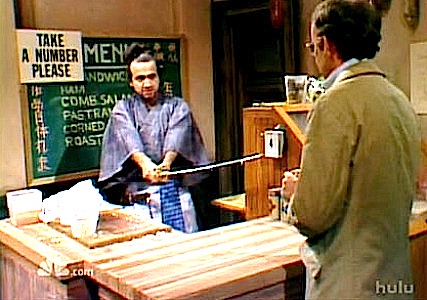
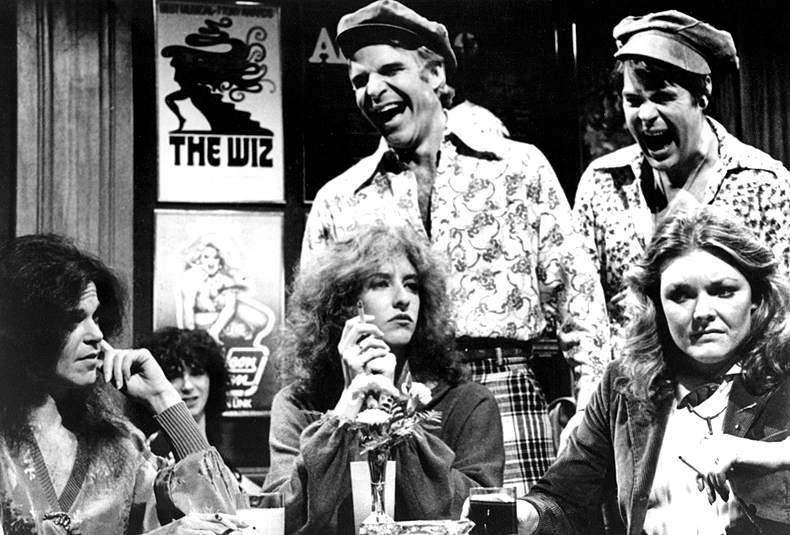
ODDEST OPENING LINES
OF A RESTAURANT
REVIEW SO FAR THIS YEAR
“`Who doesn’t want to sleep with Sheryl?'” asked the
man to my left. `But Rick?'
The man shuddered at the thought, and the piece of
barbecue beef clutched in his chopsticks dangled like
a modifier, terrified. `Even the thought of Rick
watching from the corner turns me off,' agreed the
man’s friend, who sat opposite him at the communal
table at the new RedFarm on the Upper West Side."--
Joshua David Stein, "Jewish Christmas Sublime: Ed
Schoenfeld’s RedFarm Perfects the Upper West Side’s
Only Native Cuisine," NY Observer
Any of John Mariani's
books below may be ordered from amazon.com.
 |
The Encyclopedia of American Food
and Drink by John F. Mariani
(Bloomsbury USA, $35) Modesty forbids me to praise my own new book, but let me proudly say that it is an extensive revision of the 4th edition that appeared more than a decade ago, before locavores, molecular cuisine, modernist cuisine, the Food Network and so much more, now included. Word origins have been completely updated, as have per capita consumption and production stats. Most important, for the first time since publication in the 1980s, the book includes more than 100 biographies of Americans who have changed the way we cook, eat and drink -- from Fannie Farmer and Julia Child to Robert Mondavi and Thomas Keller. "This book is amazing! It has entries for everything from `abalone' to `zwieback,' plus more than 500 recipes for classic American dishes and drinks."--Devra First, The Boston Globe. "Much needed in any kitchen library."--Bon Appetit. |
"Eating Italian will never be the same after reading John Mariani's entertaining and savory gastronomical history of the cuisine of Italy and how it won over appetites worldwide. . . . This book is such a tasteful narrative that it will literally make you hungry for Italian food and arouse your appetite for gastronomical history."--Don Oldenburg, USA Today. "Italian
restaurants--some good, some glitzy--far
outnumber their French rivals. Many of
these establishments are zestfully described
in How Italian Food Conquered the World, an
entertaining and fact-filled chronicle by
food-and-wine correspondent John F.
Mariani."--Aram Bakshian Jr., Wall Street
Journal.
"Equal parts
history, sociology, gastronomy, and just
plain fun, How Italian Food Conquered the
World tells the captivating and delicious
story of the (let's face it) everybody's
favorite cuisine with clarity, verve and
more than one surprise."--Colman Andrews,
editorial director of The Daily
Meal.com. "A fantastic and fascinating
read, covering everything from the influence
of Venice's spice trade to the impact of
Italian immigrants in America and the
evolution of alta cucina. This book will
serve as a terrific resource to anyone
interested in the real story of Italian
food."--Mary Ann Esposito, host of PBS-TV's
Ciao
Italia. "John Mariani has written the
definitive history of how Italians won their
way into our hearts, minds, and
stomachs. It's a story of pleasure over
pomp and taste over technique."--Danny Meyer,
owner of NYC restaurants Union Square Cafe,
Gotham Bar & Grill, The Modern, and
Maialino.
|
 |
 |
 |
 |
 |
 |
 |
 |
 Everett Potter's Travel Report:
Everett Potter's Travel Report: 
 Eating Las Vegas
is the new on-line site for Virtual Gourmet
contributor John A. Curtas., who since 1995
has been commenting on the Las Vegas food
scene and reviewing restaurants for Nevada
Public Radio. He is also the
restaurant critic for KLAS TV, Channel 8 in
Las Vegas, and his past reviews can be
accessed at KNPR.org.
Click on the logo below to go directly to
his site.
Eating Las Vegas
is the new on-line site for Virtual Gourmet
contributor John A. Curtas., who since 1995
has been commenting on the Las Vegas food
scene and reviewing restaurants for Nevada
Public Radio. He is also the
restaurant critic for KLAS TV, Channel 8 in
Las Vegas, and his past reviews can be
accessed at KNPR.org.
Click on the logo below to go directly to
his site.

Tennis Resorts Online: A Critical Guide to the World's Best Tennis Resorts and Tennis Camps, published by ROGER COX, who has spent more than two decades writing about tennis travel, including a 17-year stretch for Tennis magazine. He has also written for Arthur Frommer's Budget Travel, New York Magazine, Travel & Leisure, Esquire, Money, USTA Magazine, Men's Journal, and The Robb Report. He has authored two books-The World's Best Tennis Vacations (Stephen Greene Press/Viking Penguin, 1990) and The Best Places to Stay in the Rockies (Houghton Mifflin, 1992 & 1994), and the Melbourne (Australia) chapter to the Wall Street Journal Business Guide to Cities of the Pacific Rim (Fodor's Travel Guides, 1991).


MARIANI'S VIRTUAL GOURMET
NEWSLETTER is published weekly. Editor/Publisher: John
Mariani.
Contributing Writers: Christopher Mariani, Robert Mariani,
John A. Curtas, Edward Brivio, Mort Hochstein,
Suzanne Wright, and Brian Freedman. Contributing
Photographers: Galina Stepanoff-Dargery,
Bobby Pirillo. Technical Advisor: Gerry McLoughlin.
To un-subscribe from this newsletter,click here.
© copyright John Mariani 2014
